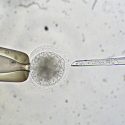UW eye researchers key to major study of diabetic eye disease
UW-Madison ophthalmologists analyzed thousands of eye photographs as part of a large study that says reducing blood lipid levels slows the progression of diabetic retinopathy, the most common diabetic eye problem and a major cause of blindness worldwide.
“This study shows that controlling blood sugar and lipids are the best ways for diabetics to protect their eyes.”
Ronald Danis
The Action to Control Cardiovascular Risk in Diabetes (ACCORD) Eye Study, published in today’s online New England Journal of Medicine, enrolled nearly 3,000 adults with type 2 diabetes who were at especially high risk for heart attack, stroke or death from cardiovascular disease. The results are also being presented at the American Diabetes Association meeting.
The study evaluated three ways to lower cardiovascular risks associated with diabetes:
- Intensive control of blood sugar to near-normal level;
- Intensive control of blood pressure to near-normal level; and,
- Combination treatment of elevated blood lipids with a fibrate and a statin compared to standard treatment with statin alone.
The study found that intensive blood-sugar control reduced the progression of diabetic retinopathy compared with standard blood-sugar control.
However, because intensive control increased the risk of death by 22 percent, researchers stopped the intensive blood-sugar strategy after an average of three and a half years of treatment, instead of the planned length of just more than five years. The study confirmed that combination lipid-lowering therapy with a fibrate and statin reduced the progression of diabetic retinopathy compared with statin therapy alone.
Intensive blood-pressure control did not show benefits for the eyes.
In an accompanying editorial, Dr. Barbara Klein, a UW professor of ophthalmology and visual sciences professor, called the 40 percent reduction in retinopathy progression created by the lipid-lowering combination “an exciting finding.”
She also noted that limiting eye damage from diabetes has other benefits.
“Perhaps more critical,’’ she writes, “is that retinopathy occurs either simultaneously or before systemic complications involving small blood vessels, such as renal disease, as well as neuropathy and complications affecting large blood vessels.”
Dr. Ronald Klein, colleague and husband of Dr. Barbara Klein, said the ACCORD study was too short to see a protective effect of intensive glycemic control in reducing more severe effects of diabetes, such as the need for photocoagulation for certain retinal diseases or for dialysis for end-stage renal disease.
Writing in this week’s edition of the Lancet about another paper from ACCORD, Klein said it took another study nearly 10 years to demonstrate the benefit of controlling blood sugar in reducing the incidence of these advanced diabetic complications. Klein writes “…with the expected doubling or tripling in the number of people worldwide who will develop type 2 diabetes over the next 20 to 30 years, it is important that ACCORD’s findings not be misinterpreted as a justification for a return to poor glycemic control.”
In the ACCORD Eye Study, researchers analyzed the progression of diabetic retinopathy over four years in 2,856 participants. The analysis took place at the Fundus Photograph Reading Center, part of the UW Department of Ophthalmology and Visual Sciences. The retina photos were evaluated on a retinopathy severity scale developed at UW.
Wisconsin faculty and staff, including Dr. Ronald Danis, Dr. Mathew Davis, Dr. Sapna Gangaputra and researchers Larry Hubbard and Barbara Esser, helped write the NEJM article.
“These are important findings given the number of people who have diabetes now or are at risk of developing it,’’ says Danis. “This study shows that controlling blood sugar and lipids are the best ways for diabetics to protect their eyes.”
More than four million American adults age 40 and older have been diagnosed with diabetic retinopathy; between 40 and 45 percent of those diagnosed with diabetes have some degree of the disease. In diabetic retinopathy, diabetes damages blood vessels in the eye’s light-sensitive retinal tissue. The blood vessels can begin to leak, causing swelling in the retina, which results in vision loss. In addition, abnormal new blood vessels can develop and cause vision loss.
The ACCORD Eye Study was funded by the National Eye Institute.



